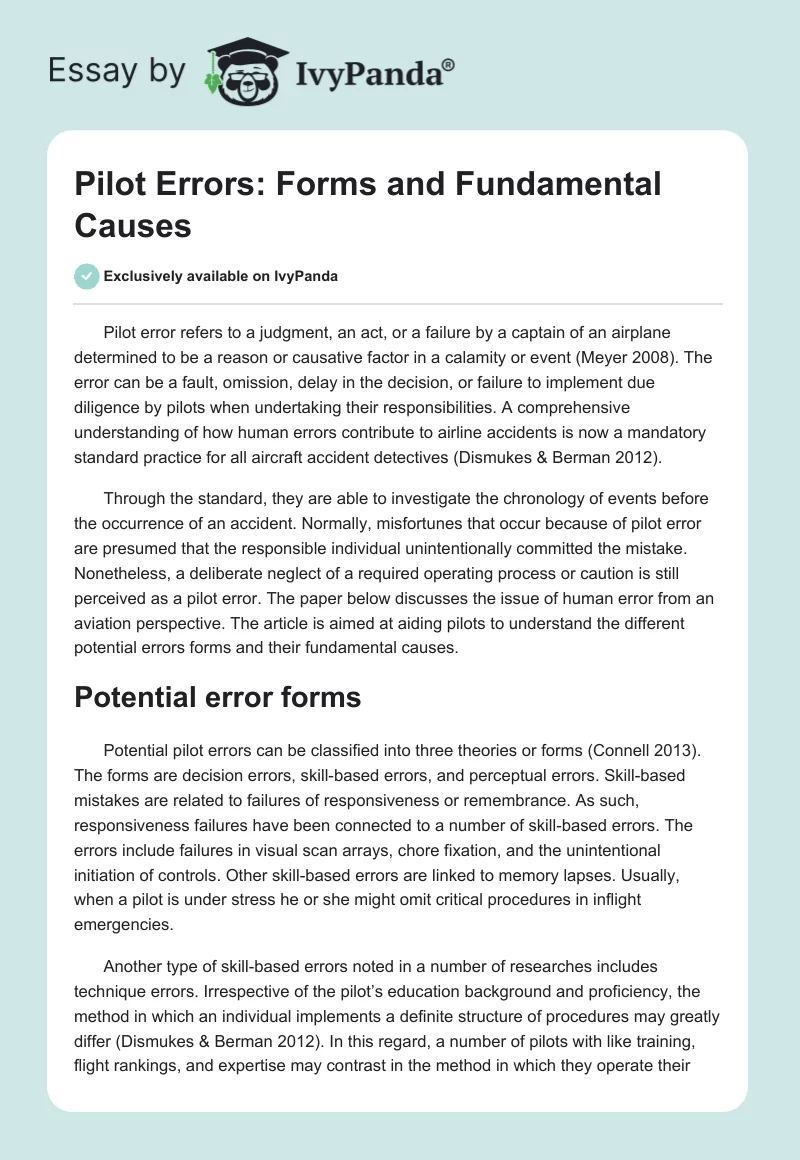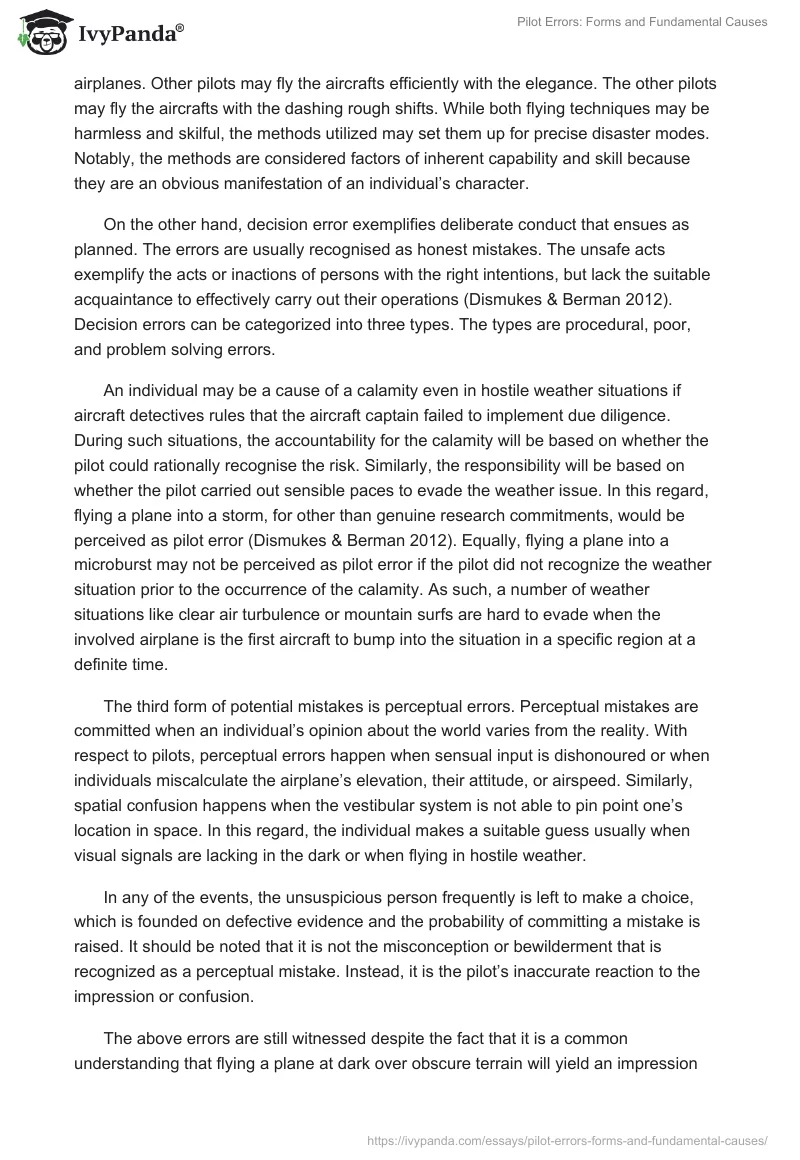Pilot error refers to a judgment, an act, or a failure by a captain of an airplane determined to be a reason or causative factor in a calamity or event (Meyer 2008). The error can be a fault, omission, delay in the decision, or failure to implement due diligence by pilots when undertaking their responsibilities. A comprehensive understanding of how human errors contribute to airline accidents is now a mandatory standard practice for all aircraft accident detectives (Dismukes & Berman 2012).
Through the standard, they are able to investigate the chronology of events before the occurrence of an accident. Normally, misfortunes that occur because of pilot error are presumed that the responsible individual unintentionally committed the mistake. Nonetheless, a deliberate neglect of a required operating process or caution is still perceived as a pilot error. The paper below discusses the issue of human error from an aviation perspective. The article is aimed at aiding pilots to understand the different potential errors forms and their fundamental causes.
Potential error forms
Potential pilot errors can be classified into three theories or forms (Connell 2013). The forms are decision errors, skill-based errors, and perceptual errors. Skill-based mistakes are related to failures of responsiveness or remembrance. As such, responsiveness failures have been connected to a number of skill-based errors. The errors include failures in visual scan arrays, chore fixation, and the unintentional initiation of controls. Other skill-based errors are linked to memory lapses. Usually, when a pilot is under stress he or she might omit critical procedures in inflight emergencies.
Another type of skill-based errors noted in a number of researches includes technique errors. Irrespective of the pilot’s education background and proficiency, the method in which an individual implements a definite structure of procedures may greatly differ (Dismukes & Berman 2012). In this regard, a number of pilots with like training, flight rankings, and expertise may contrast in the method in which they operate their airplanes. Other pilots may fly the aircrafts efficiently with the elegance. The other pilots may fly the aircrafts with the dashing rough shifts. While both flying techniques may be harmless and skilful, the methods utilized may set them up for precise disaster modes. Notably, the methods are considered factors of inherent capability and skill because they are an obvious manifestation of an individual’s character.
On the other hand, decision error exemplifies deliberate conduct that ensues as planned. The errors are usually recognised as honest mistakes. The unsafe acts exemplify the acts or inactions of persons with the right intentions, but lack the suitable acquaintance to effectively carry out their operations (Dismukes & Berman 2012). Decision errors can be categorized into three types. The types are procedural, poor, and problem solving errors.
An individual may be a cause of a calamity even in hostile weather situations if aircraft detectives rules that the aircraft captain failed to implement due diligence. During such situations, the accountability for the calamity will be based on whether the pilot could rationally recognise the risk. Similarly, the responsibility will be based on whether the pilot carried out sensible paces to evade the weather issue. In this regard, flying a plane into a storm, for other than genuine research commitments, would be perceived as pilot error (Dismukes & Berman 2012). Equally, flying a plane into a microburst may not be perceived as pilot error if the pilot did not recognize the weather situation prior to the occurrence of the calamity. As such, a number of weather situations like clear air turbulence or mountain surfs are hard to evade when the involved airplane is the first aircraft to bump into the situation in a specific region at a definite time.
The third form of potential mistakes is perceptual errors. Perceptual mistakes are committed when an individual’s opinion about the world varies from the reality. With respect to pilots, perceptual errors happen when sensual input is dishonoured or when individuals miscalculate the airplane’s elevation, their attitude, or airspeed. Similarly, spatial confusion happens when the vestibular system is not able to pin point one’s location in space. In this regard, the individual makes a suitable guess usually when visual signals are lacking in the dark or when flying in hostile weather.
In any of the events, the unsuspicious person frequently is left to make a choice, which is founded on defective evidence and the probability of committing a mistake is raised. It should be noted that it is not the misconception or bewilderment that is recognized as a perceptual mistake. Instead, it is the pilot’s inaccurate reaction to the impression or confusion.
The above errors are still witnessed despite the fact that it is a common understanding that flying a plane at dark over obscure terrain will yield an impression that the airplane is in reality elevated than in reality. Therefore, pilots are required to depend on their key instruments instead of the immediate surroundings in the approach stage of flying. Nonetheless, a number of aviators fail to keep an eye on their appliances when flying in the dark. Unfortunately, these flight personnel may end up committing deadly aircraft calamities if they fail to be observant.
Fundamental causes
Improper use of a checklist is a major cause of accidents linked to pilot error. It is very rare for aviators to skip the checklist purposely. However, during stretched taxi routes to a distant take off strip the risks of the pilots becoming hampered by redundant chitchat increases. In this regard, the risk of overlooking the prior take-off checklist increases. Notably, the pilots should be cautious of how they read their checklist. If the checklist is read and implemented without paying attention to the switches, the efficiency of the checklist is compromised. Therefore, it requires a huge level of self-discipline for the pilot to vigorously adhere to a checklist and not be hampered by other flight crewmembers. In this respect, co-pilots should always observe their pilots while reading their checklists. If any negligence is noted, the co-pilot should encourage the pilot to focus on the checklist.
Another major cause of pilot errors is the failure to adhere to, standard-operating procedures, SOPs. Each airline has diverse standard operating procedures (SOPs). The procedures are often altered when training staff is changed. In this regard, airline companies that change their pilots more often may experience challenges in implementing new SOPs. SOPs allocate responsibilities between two aviators on a multi crew flight deck. Both pilots are informed about the button to initiate and what call-out is to be made or anticipated. The standard operating procedures make two cogwheels move in a series and assure that all flight deck responsibilities are undertaken in a systematic manner. SOPs may look strange and it may occasionally be challenging to comprehend the logic that went behind the conception of a certain procedure.
Initially, the procedures were formulated with the aim of reducing pilot errors, which have led to a number of deadly accidents. For instance, a couple of years ago crewmembers and travellers on a Cypriot 737 airplane became unconscious as the airplane scaled with an unpressurized cabin (Callantine 2012). The plane scaled on an autopilot mode and had a fatal accident an hour later after the engine exhausted its gas. Following the accident, a number of airline companies restructured their SOPs by adding a procedure that required inspection of the pressurization system in the course of preliminary ascent. Thus, if an individual does not comprehend or come to an agreement with an airline’s SOP he or she should constantly read the procedures.
The handwriting has also been blamed as another cause of accidents linked to pilot error. It has been noted that some pilots’ handwritings are difficult to read. Unreadable scripts weaken flight safety. Many times in a year, the load-sheet is documented with void weights merely because the preliminary figures created by the flight crew were illegible. One year ago, an airline had an in-flight engine closure owing to poor handwriting (Dismukes & Berman 2012).
An extreme fuel disparity detected on departure was deduced as fuel seepage because of an unclear outstanding fuel entry. The figures on the on Tech Log had illegible handwriting entered by the previous crew. Fellow crewmembers and ground personnel may have diverse cultural backgrounds. Therefore, occasionally they may use illegible handwriting or different alphabets when entering data. With illegible handwriting, simple figures may be understood wrongly. Therefore, all pilots and crewmembers should put an extra effort and self-control to write clearly. It is highly recommended that clear handwriting be used when recording weather statistics, when entering load sheets, and when assessing aircraft performance.
Conclusion
Based on the above illustrations, theories, and models, it is apparent that an understanding of pilot error is very useful. As such, pilot error can be a fault, omission, delay in the decision, or failure to implement due diligence by aviators when undertaking their responsibilities. Normally, misfortunes that occur because of pilot error are presumed that the responsible pilot unintentionally committed the mistake. Nonetheless, a deliberate neglect of a required operating process or caution is still perceived as a pilot error. A comprehensive understanding of how human errors contribute to airline accidents is now a mandatory standard practice for all aircraft accident detectives.
Through this, they are able to investigate the chronology of events before the occurrence of an accident. Potential pilot errors can be classified into three forms. The forms are decision errors, skill-based errors, and perceptual errors. All the pilots should be informed about these probable errors.
Improper use of a checklist, illegible handwriting, and failure to adhere to standard-operating procedures are a major cause of accidents linked to pilot error. Co-pilots should regularly keep an eye on their pilots while reading their checklists. If any negligence is noted, the co-pilot should encourage the pilot to focus on the checklist. Similarly, it is highly recommended that clear handwriting be used when recording weather statistics, when entering load sheets, and when assessing aircraft performance. Through this, accidents linked to pilot error will be reduced.
References
Callantine, T 2012. Activity tracking for pilot error detection from flight data. Ames Research Center, Moffett Field, CA. Web.
Connell, J 2013, Air transport in the 21st century key strategic developments. Ashgate, Farnham, Surrey, England. Web.
Dismukes, K., & Berman, B 2012, The limits of expertise rethinking pilot error and the causes of airline accidents. Ashgate, Aldershot. Web.
Meyer, M 2008, Pilot error. Goldrock Press, Norway House, Man. Web.


